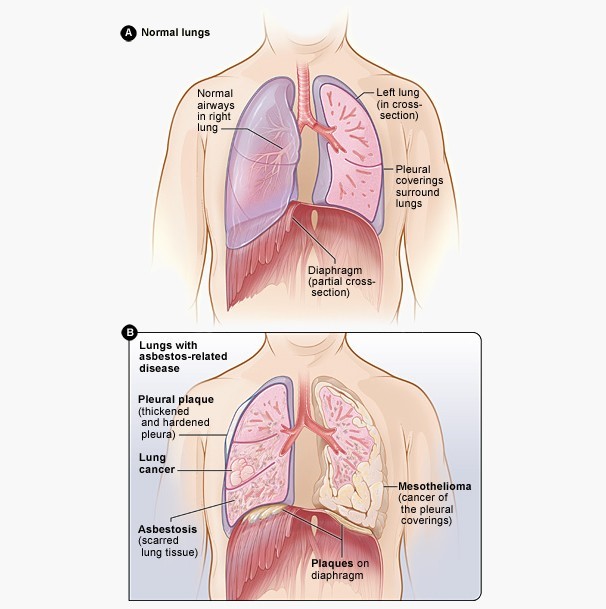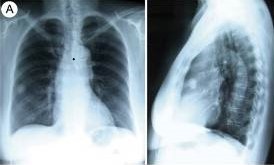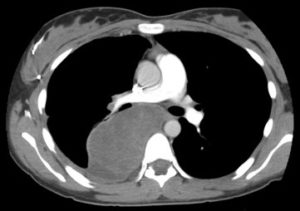Mesothelioma
Mesothelioma
Mesothelioma (mez´-o-thee´-lee-oh´-muh) is a rare but aggressive cancer that affects the thin layer of tissue (mesothelium) that lines your lungs, abdomen, heart, and other organs. Mesothelioma most often affects the tissue that surrounds the lungs (pleura).
About 3,000 cases of mesothelioma are diagnosed in the United States each year, according to the American Cancer Society.
In the US, the disease is more common in men, whites, and Hispanics/Latinos. Mesothelioma is typically diagnosed when the patient is between the ages of 50 and 70.

Causes Of Mesothelioma
The main cause of mesothelioma is believed to be repeated exposure to asbestos, a naturally occurring group of minerals that is made up of tiny fibers and is found in soil and rocks around the world. When asbestos fibers are in the air and you breathe them in, they can get caught in your lungs. It usually takes 20 years for mesothelioma to develop after exposure.
Asbestos was previously used to make fireproof materials, such as theater curtains, insulation, flooring, and workers’ gloves. Although the use of asbestos has dramatically decreased over the past few decades, it is still used in some products. People at the highest risk for asbestos exposure in the workplace include miners, factory workers, plumbers, and construction workers.
Living with a person who works near asbestos is also a risk factor for malignant mesothelioma because asbestos fibers some times are brought home on clothes.
Some research has found a link between mesothelioma and a monkey virus in a polio vaccine that was given between 1955 and 1963.
Symptoms Of Mesothelioma
- Shortness Of Breath
- Chest Pain
- Fatigue
- Swelling Of The Face And Arms
- Unexplained Weight Loss
Pleural mesothelioma affects the lining of the lungs (pleura). Symptoms include:
- Chest pain under the rib cage
- Shortness of breath
- Painful coughing
- Fever
- Fatigue
- Unexplained weight loss
- Swelling of the face and arms
For people with known exposure to asbestos, some doctors recommend initial screening with blood tests and imaging tests, such as chest radiography (X-rays) and computed tomography (CT scans).
Diagnosis And Treatment Options

Chest x-ray showing a benign fibrous tumor of the pleura

CT scan revealing a pleural tumor
If these tests indicate mesothelioma is likely, the only way to confirm the disease is through a biopsy, which involves the removal of fluid or tissue that will be examined under a microscope.
Depending on what area of your body is affected, your doctor will select the right biopsy procedure for you. Options include:
- Fine-needle aspiration — the doctor will remove fluid or a piece of tissue with a small needle inserted into your chest or abdomen.
- Thoracoscopy — the surgeon will make one or more small incisions between your ribs. A tube with a tiny video camera will then be inserted into your chest cavity so that the surgeon can cut away small pieces of tissue for testing.Laparoscopy — the surgeon will make one or more small incisions in your abdomen. A tiny camera will be inserted so that the surgeon can remove a small piece of tissue for testing.
- Thoracotomy — the surgeon will open your chest between the ribs to check for signs of the disease. A sample of tissue may be removed for testing.
- Laparotomy — the surgeon will open your abdomen to check for signs of disease. A sample of tissue may be removed for testing.
Once mesothelioma is diagnosed, your doctor will order additional tests—likely more imaging tests such magnetic resonance imaging (MRIs) and/or positron emission tomography (PET scans)—to determine the extent, or stage, of the cancer.
There currently is no cure for advanced stage mesothelioma.
Your treatment will vary depending on the type of mesothelioma you have and how much it has progressed. If your disease is caught early, you will have a better chance for survival. If your disease is in an advanced stage, the 5-year survival rate is only about 10%. Based on these factors, your treatment options may include surgery, radiation therapy, and/or chemotherapy.
If surgery is recommended, a cardiothoracic surgeon may perform one of the following procedures to either remove all of the disease or ease the symptoms.
Extrapleural Pneumonectomy (EPP)
Surgery to remove one lung, the affected chest lining, the diaphragm, and the lining of the heart. The diaphragm and heart lining are then reconstructed with man-made materials.
Pleurectomy/ Decortication (P/D)
Surgery to remove the lining of the chest cavity and one lung, as well as part of the lung surface. This preserves the lung.
Debulking (Partial Pleurectomy)
A surgical procedure that is similar to a P/D, but removes less tissue and still preserves the lung.
As with any surgical procedure, operations used to treat mesothelioma can have serious risks and side effects, although these depend on the extent of the surgery and the person’s health beforehand.
Recovery
Serious complications of any of the surgeries can include bleeding, blood clots, wound infections, changes in heart rhythm, pneumonia, fluid buildup in the chest, and loss of lung function.
Most of these symptoms are less common with less extensive operations.
Because the surgeon must often spread the ribs during surgery, the incision will hurt for some time afterward. Your activity may be limited for at least a few months if not more.
